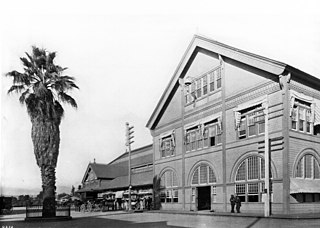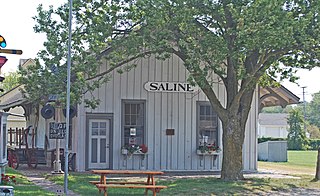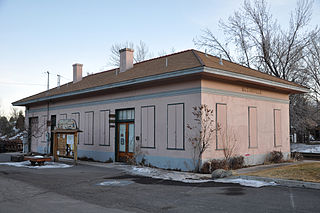
Cincinnati Union Terminal is an intercity train station and museum center in the Queensgate neighborhood of Cincinnati, Ohio. Commonly abbreviated as CUT, or by its Amtrak station code, CIN, the terminal is served by Amtrak's Cardinal line, passing through Cincinnati three times weekly. The building's largest tenant is the Cincinnati Museum Center, comprising the Cincinnati History Museum, the Museum of Natural History & Science, Duke Energy Children's Museum, the Cincinnati History Library and Archives, and an Omnimax theater.

The Illinois Terminal Railroad Company, known as the Illinois Traction System until 1937, was a heavy duty interurban electric railroad with extensive passenger and freight business in central and southern Illinois from 1896 to 1956. When Depression era Illinois Traction was in financial distress and had to reorganize, the Illinois Terminal name was adopted to reflect the line's primary money making role as a freight interchange link to major steam railroads at its terminal ends, Peoria, Danville, and St. Louis. Interurban passenger service slowly was reduced, ending in 1956. Freight operation continued but was hobbled by tight street running in some towns requiring very sharp radius turns. In 1956, ITC was absorbed by a consortium of connecting railroads.

Oklahoma City Union Depot is a building in Oklahoma City, Oklahoma that served as a "union station" from 1931 until 1967. It was listed on the National Register of Historic Places in 1979. It now houses the offices of the Scissortail Park Foundation.

Charlotte station is an Amtrak station located at 1914 North Tryon Street, about 1.5 miles (2.4 km) to the northeast of Uptown Charlotte. Owned by Norfolk Southern, it is located near that railroad's yard outside Uptown.

J. Douglas Galyon Depot, also known as Greensboro station, is an intermodal transit facility in Greensboro, North Carolina. Located at 236 East Washington Street in downtown Greensboro, it serves Amtrak passenger rail and is the city's main hub for local and intercity buses.

Waterloo station is an Amtrak train station in Waterloo, Indiana. Waterloo is a small town of under 2,500 people; the station primarily serves the vastly larger population of Fort Wayne, which is some 25 miles (40 km) to the south. The station opened in 1990; in 2016, the former New York Central Railroad station building was moved and reopened for passenger use. The station has a waiting room and restroom facilities; it is open for only short periods before trains arrive.

Union Station is an Amtrak railroad station and mixed-use commercial building in downtown Erie, Pennsylvania, United States. It is served by the Lake Shore Limited route, which provides daily passenger service between Chicago and New York City or Boston; Erie is the train's only stop in Pennsylvania. The station's ground floor has been redeveloped into commercial spaces, including The Brewerie at Union Station, a brewpub. The building itself is privately owned by the global logistics and freight management company Logistics Plus and serves as its headquarters.

The Apex Union Depot is a historic railroad station located on Salem Street in downtown Apex, North Carolina and is the centerpiece of the Apex Historic District. Constructed in 1914 by the Seaboard Air Line Railroad, the building shared service with the Durham and Southern Railway, but now houses the Apex Visitor's Center, Apex Chamber of Commerce, and meeting rooms rented out for special events. A 37-foot Louisville and Nashville Railroad caboose is located beside the building. In December 1998 the Apex Union Depot was listed on the National Register of Historic Places.
Southern Railway Depot, or variations such as Southern Railway Passenger Station or Passenger Depot, Southern Railway Freight Depot or Freight Office, may refer to any of numerous railway stations operated by the U.S.-based Southern Railway or stations operated by other Southern Railway companies.

Barnesville station is a historic train station in Barnesville, Ohio. It is located at 300 East Church Street, between Mulberry and Railroad Streets. The building was placed on the National Register of Historic Places on August 8, 1985, as the Barnesville Baltimore and Ohio Railroad Depot.

The Nevada–California–Oregon Railway Passenger Station is a historic train station in Lakeview, Oregon, United States. It was built in 1912 by contractor I. A. Underwood from plans by architect Frederic DeLongchamps. It was the northern terminus of the Nevada–California–Oregon Railway. The Southern Pacific Railroad company owned and operated the depot from 1928 until 1975, when it was closed. Since 1978, the building has been used as a law office and later a private residence. Because of its importance to local history, the depot was listed on the National Register of Historic Places in 1983.

The Baltimore and Potomac Railroad Station, also known as Pennsylvania Railroad Station, was a railroad station that was owned by the Pennsylvania Railroad and operated by the Baltimore and Potomac Railroad in Washington, D.C., from July 2, 1872 until its closure in 1907. It was located at the southern corner of 6th street NW and B Street NW, now the site of the West Building of the National Gallery of Art. It was in this train station that United States President James A. Garfield was shot by assassin Charles J. Guiteau on July 2, 1881.

The Arcade Depot was the main Southern Pacific Railroad passenger railway station of Los Angeles, California between 1888 and 1914. It was located on Alameda Street, between 5th and 6th Streets. This station consolidated intercity services at a location closer to Downtown Los Angeles than the previous terminal, the San Fernando Street Depot.

The Indianapolis Traction Terminal was a major interurban train station in downtown Indianapolis, Indiana. It was the largest interurban station in the world and at its peak handled 500 trains per day and seven million passengers per year. The station opened in 1904 and remained in use until 1941, when interurban operation ended. It continued to serve as a bus station until 1968 and was demolished in 1972. The Hilton Indianapolis now stands at its location.

The Third and Townsend Depot was the main train station in the city of San Francisco for much of the first three quarters of the 20th century. The station at Third Street and Townsend Street served as the northern terminus for Southern Pacific's Peninsula Commute line between San Francisco and San Jose and long-distance trains between San Francisco and Los Angeles via the Southern Pacific's Coast Line. For service for destinations to the north, such as Seattle, and destinations to the east, such as Chicago, passengers generally needed to travel to Oakland, initially on ferries to Oakland Long Wharf, and later on buses to 16th Street Station. It was demolished in the 1970s and replaced by the Caltrain commuter station a block away at Fourth and King Streets.

The Toledo and Ohio Central Railroad Station, today named Station 67, is a union meeting space and event hall located in Franklinton, near Downtown Columbus, Ohio. Built by the Toledo and Ohio Central Railroad from 1895 to 1896, it served as a passenger station until 1930. It served as an office and shelter for Volunteers of America from 1931 to 2003, and has been the headquarters of International Association of Fire Fighters Local 67, a firefighters' union, since 2007. The building was placed on the National Register of Historic Places in 1973. During its history, the building has experienced fires and floods, though its relatively few owners have each made repairs and renovations to preserve the building's integrity. The building is the last remaining train station in Columbus.
The Valley Railway was a shortline railroad which operated between the city of Cleveland and small town of Zoarville in the state of Ohio in the United States. The railroad was founded in 1871, but the first segment of track did not open until 1880 and the line was not completed until 1884. The Baltimore and Ohio Railroad (B&O) obtained a controlling interest in the Valley Railway in 1890. The railroad went bankrupt in 1895, at which time it was reorganized as The Cleveland Terminal and Valley Railroad Company (CT&V). The B&O took over operation of the CT&V in 1909, and the company was merged with the B&O in 1915.

The Saline station, also known as the Detroit, Hillsdale and Indiana Railroad-Saline Depot, is a former railroad depot located at 402 North Ann Arbor Street in Saline, Michigan. It was listed on the National Register of Historic Places in 1994. The building now houses the Saline Depot Museum.

The Susanville Railroad Depot is a National Register of Historic Places property in Lassen County, California in the city of Susanville. Originally constructed for the Fernley and Lassen Railway in 1927 to replace an existing station building, it was closed in 1979, and in 1987 it was saved from being burnt by the fire department after local protests, being purchased instead by the Lassen Land and Trails Trust, which uses it for their office as well as maintaining a small museum.

The Southern Railway Building is a historic office building located in Washington, D.C., United States. It was built in 1928–1929 by local architect Waddy Butler Wood as the executive headquarters for the Southern Railway. The eleven-story building was designed in the Stripped Classical style with early Art Deco elements, and was constructed with a frame of steel and concrete fronted with limestone and set on a granite base. The site functioned as the railway's headquarters until 1982, when the company merged with the Norfolk and Western Railway. The newly-formed Norfolk Southern Railway moved its headquarters to Norfolk, Virginia, and the Southern Railway Building became privately owned with multiple tenants. It was listed on the National Register of Historic Places and District of Columbia Inventory of Historic Sites in 2016. It is also a contributing property to the Financial Historic District.




















